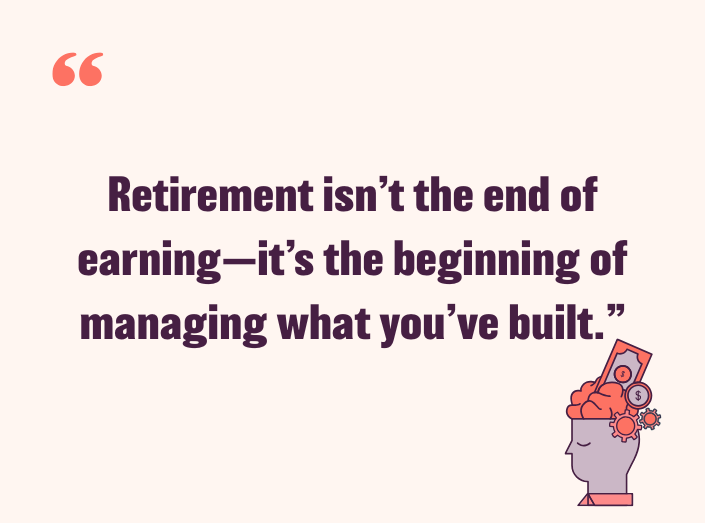In plain English, here’s what’s going on
Thinking about retirement income planning might feel overwhelming — but it’s one of the most important financial steps you’ll ever take. Whether you’re 10 years away from retiring or already there, a solid plan helps ensure you’ll have enough income to cover your needs, enjoy life, and handle unexpected expenses.
In the UK, retirement can last 30 years or more. That means your savings and pension pot need to work hard for you — not just at the start, but throughout your later years. By reviewing your options, understanding the tax implications, and making informed decisions now, you can turn your savings into a stable, lasting retirement income.
This guide walks you through 8 key steps to plan with confidence, avoid common mistakes, and secure your financial future.

Here’s how to build a steady income plan that works for you:
Estimate Your Retirement Spending Needs
Before you start deciding where your retirement income will come from, it’s crucial to understand how much you’ll actually need. This means thinking beyond basic living costs like food and bills. Consider hobbies, travel, unexpected health expenses, and rising inflation.
Some use the 70–80% rule — aiming for income that replaces around 70% of your final salary. But the more accurate way is to calculate your own personal expenses based on your lifestyle. List your regular and occasional expenses to get a realistic monthly income target.
Once you know how much you’ll need, you can start shaping your plan around how much you have — and what you need to close the gap.
Review All Pension Sources
Your pension will likely form the foundation of your retirement income. Start by reviewing your workplace pensions, personal pensions, and your expected State Pension. If you’ve worked for multiple employers, it’s likely you have more than one pension pot. Use the government’s Pension Tracing Service if you’ve lost track of any.
Then, check your State Pension forecast at gov.uk. This will show when you can retire, and how much you’re currently on track to receive. For most people, the State Pension alone isn’t enough to cover all retirement needs, so understanding the full picture is essential.
Remember that you may be able to take up to 25% of your pension pot as a tax free lump sum — but doing so will reduce what’s left to generate regular income in the future.
Build Other Sources of Retirement Income
While pensions are the cornerstone, they’re not the only option. Many people also rely on other savings, such as individual savings accounts (ISAs), investments, property income, or business revenue to provide more income in retirement.
If you’re still saving, consider putting more into ISAs for tax-free withdrawals or using regular contributions to build investment funds. If you’re already retired, look at how best to use these assets alongside your pension savings to spread your income over time.
The key is to create a mix of income streams — some guaranteed, some flexible — that give you both stability and freedom.

Understand Your Tax Position
Tax is one of the most overlooked areas of retirement income planning, but it can make a big difference. When you start withdrawing from your pension pot, only the first 25% is usually tax free. The rest is treated like income, which means you may pay tax depending on how much you withdraw and what other income you have.
It’s important to consider which pots to draw from first, how to avoid creeping into a higher tax band, and whether lump sum withdrawals are worth it. For example, drawing from ISAs before pensions can delay income tax. Or spreading out pension contributions over several years may avoid pushing your annual income into a higher tax bracket.
Speaking with a financial adviser or tax planner is highly recommended here, as the tax implications vary widely depending on your individual circumstances.
Choose the Right Retirement Income Option
When you’re ready to draw from your pension pot, you’ll need to decide how to do it. There are a few main retirement options:
- Annuities offer a guaranteed income for life or a set period. These are ideal if you want stability and predictability.
- Flexi-access drawdown lets you leave your money invested while taking out income as needed. It offers flexibility but carries investment risk.
- Uncrystallised funds pension lump sums (UFPLS) allow you to take lump sums from your pension pot — with 25% of each being tax free and the rest taxed as income.
The right choice depends on your needs, risk tolerance, and financial goals. Many people choose a combination to balance guaranteed income with flexibility.
Factor in Later Life Expenses and Care
Planning your retirement income isn’t just about the early years. As you age, costs like healthcare, support services, or mobility adaptations may become significant. It’s wise to leave room in your plan for unexpected later life expenses.
Consider setting aside part of your lump sum or other savings for future care. Look into long-term care insurance or government support options, and review your estate and inheritance plans.
Many people underestimate the costs of later life, but preparing now can help you afford what’s needed without burdening your family.

Regularly Review and Adjust Your Plan
Retirement planning isn’t something you do once and forget. Markets change, tax laws evolve, and your personal situation may shift —whether it’s your health, living arrangements, or financial goals.
Make a habit of reviewing your retirement income strategy at least once a year. Update your investment performance, adjust for inflation, re-check your State Pension entitlement, and ensure your income sources are still aligned with your needs.
This is also the time to reassess your pension contributions if you’re still saving, or your withdrawal strategy if you’ve already retired.
Speak to a Financial Adviser
Finally, one of the smartest things you can do is consult a qualified financial adviser — especially one with experience in retirement income planning. They can offer personalised advice, assess your pension pot and other assets, and help you make informed decisions tailored to your individual circumstances.
An adviser can help you optimise your tax benefits, plan a sustainable income drawdown, and balance risk with reward. The earlier you get expert help, the more options you’ll have — and the fewer surprises down the road

Effective retirement income planning is about more than just pensions. It’s about building a realistic, tax-efficient, and flexible plan that supports your life goals — not just at the start of retirement, but all the way through.
By taking these 8 steps — estimating your needs, reviewing all your pension savings, building multiple income sources, understanding tax implications, choosing the right withdrawal strategy, factoring in future expenses, keeping your plan updated, and seeking expert advice —you can retire with confidence and clarity.
Your financial future is too important to leave to chance. Start planning today, and give yourself the freedom to enjoy everything retirement has to offer.
-
5 secrets to live a secure financial life
Whatever life throws at you - get prepared to have your finances under control. A good financial plan can help you prepare for all... -
What are my retirement options?
-
5 Retirement Planning Mistakes Women Make (And How to Avoid Them)
Many women face unique challenges when saving for retirement. Learn the five biggest retirement planning mistakes women make and h...


